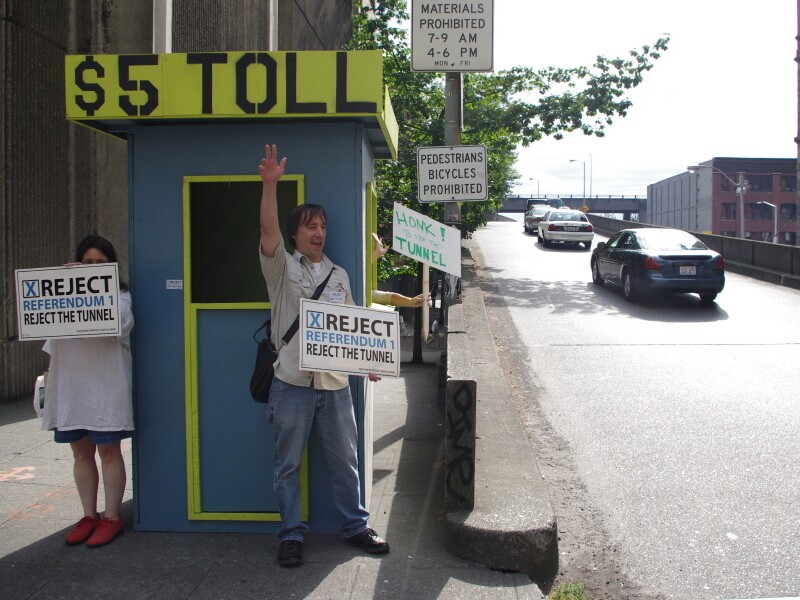With our free press under threat and federal funding for public media gone, your support matters more than ever. Help keep the LAist newsroom strong, become a monthly member or increase your support today.
Future Of Shaky Viaduct Divides Seattle Residents

Downtown Seattle is one earthquake away from a transportation catastrophe. The city's last big quake in 2001 seriously weakened an elevated highway called the Alaskan Way Viaduct, and engineers say another good shake could bring the double-decker structure down. Although the city has been living with the threat for 10 years, residents and politicians still can't agree what to do about it.

The elevated highway runs along Seattle's downtown waterfront, and when you stand underneath it, it's hard not to think of those pancaked freeways in the 1989 San Francisco earthquake. Elliot Kreeger recently stopped there for a hot dog — right below Seattle's Viaduct of Damocles.
"I'd like it taken down before it falls down," Kreeger says of the viaduct.
Kreeger lives near the waterfront, where you get gorgeous views of the Olympic Mountains and Puget Sound. That is, where the viaduct isn't in the way.
"I've always thought it was a shame that Seattle has not taken advantage of the water and this area. And this definitely is a scar," he says.
But a lot of native Seattleites are kind of fond of the old highway, like hot dog vendor Torben Bernhardt.
"It's OK ... you get a good view when you're driving on it," Bernhardt says. "It's much easier getting home on the viaduct than it is a lot of other ways downtown."
Tunnel Referendum On Ballot
This ambivalence has dragged out the debate about what to do with the viaduct. It's been through all the hoops — a stakeholder committee, City Council, a mayoral veto, a veto override. Finally, there's a plan.
King County Executive Dow Constantine, with a phalanx of business and labor reps, recently made the case for replacing the viaduct with a tunnel under downtown.
"We need to be able to keep people and freight moving," he says.
In theory, the tunnel is going to happen — the Washington Department of Transportation has already signed the contracts — but the fight is still on.
Among the tunnel's opponents are members of the group Protect Seattle Now. The group got a tunnel referendum question on the Aug. 16 primary election ballot. Some of them would like to see the viaduct rebuilt; others don't want a highway at all, just more transit. But they all agree on what they're against:
"The tunnel is the absolutely worst and most expensive alternative," says Anitra Freeman, a member of the group.
Freeman says the price tag — $4 billion or so — is just one reason not to like the tunnel. Yes, the state is paying most of the bill, but the city could get stuck with the overruns. And what happens if the tunneling machine gets stuck under downtown? Or if there's a cave-in under somebody's skyscraper?
"The people I talk to who are against the tunnel have a whole list of reasons, and have really thought about it," she says. "Everybody I've talked to who supports the tunnel, it's all for one reason: 'I'm just tired of this; I want to do something!' "
Tunnel Supporters: Americans Afraid To Think Big
It's not for nothing that the pro-tunnel campaign — funded in part by the tunnel contractors — calls itself Let's Move Forward. Campaign spokesman Alex Fryer says the ongoing resistance to the tunnel reflects the national mood — a time when economic crisis makes voters shrink from big projects.
"Your mentality kind of just starts spinning into a negative vortex where you just can't do anything. You're just paralyzed. You can't make big investments; you can't dream big dreams and make them reality, because you're sinking under this nonstop negative news," he says. "We gotta get out of it!"
Tunnel opponents worry about the opposite mentality.
"They're cutting basic health, they're cutting our K-12 system, they're cutting our highest education system," says spokeswoman Esther Handy. "And we have a transportation department that's saying 'We just need to build something, we've got billions of dollars, let's just do anything.' It's just crazy!"
This week's referendum probably won't be the last word on the issue. In the meantime, the state has installed seismically triggered gates on the viaduct, to try to limit the number of cars that are up there if and when the big one hits.
Copyright 2022 NPR. To see more, visit https://www.npr.org. 9(MDA1OTI3MjQ5MDEyODUwMTE2MzM1YzNmZA004))








